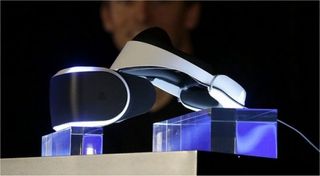VR, 3D, 4D Technology To Hit $279 Billion In Revenue By 2018

The VR headspace market is a quickly emerging one. Facebook recently dumped $2 billion into the Oculus Rift platform and Sony is making some strong headway in that department as well. While we're all pretty much privy to the fact that VR is becoming a new big hit, what a lot of people probably didn't know was that it's attached to an industry that's expected to boom over the next few years... and by boom, I mean hit $279.27 billion in annual revenue by 2018.
A new report from Markets and Markets takes a look at some of the emerging technology that's shaping the technological and electronic entertainment landscape. This includes things like stereoscopic televisions, 3D head-mounted display units (i.e., Oculus Rift, Project Morpheus) as well as 3D display segments and integrated circuitry.
According to the report, the 3D industry managed to pull in $93.21 billion back in 2013. It didn't seem as if some of this fringe tech was all that big, but it's becoming more and more standard to industrialize certain forms of 3D technology for entertainment, productivity and infrastructural purposes. By 2018 the industry is expected to hit $279.27 billion, and by 2020 the report indicates that the 3D, VR and 4D technology market will breach $470.86 billion in annual revenue.
Part of the emerging trend in this technology is 3D scanners and 3D display capturing services. What are those? Well, it's the kind of tech used to create CGI quality characters or props, similar to what you see ray tracing demonstrations. Except, in today's field we're not just looking at static objects anymore, but actual, moving parts and animations attached to these high-quality captures.
A more pertinent example is technology such as Nito Inc.'s recognition tech, which allows for markerless 3D performance capture, almost like the MotionScan technology used in Rockstar and Team Bondi's L.A. Noire. As mentioned in a brief press notice...
“Nito has created the first patent-pending markerless facial tracking technology that transposes facial movements and audio onto 3D avatars for high-quality video distribution of entertainment content. The report states that such 3D technology is currently being used in consumer and entertainment, both of which Nito supports with its cutting-edge technology.”
Nito isn't the only markerless performance capture tech out there, though. Russian software design studio iPi Soft has also consistently been using 3D markerless capture technology, fueled mostly by Microsoft's Kinect.
On the other end of the spectrum we have high-end 3D scan devices used for characters, such as the one demonstrated within Unity's 3D engine [NSFW].
CINEMABLEND NEWSLETTER
Your Daily Blend of Entertainment News
2K Games also uses similar 3D scanning technology for some of their recent and upcoming titles, such as NBA 2K14, which went down as one of the best looking games of the year. They're also employing that same 3D image scanning for the wrestlers in Yukes' upcoming WWE 2K15.
As for VR? Well, it's planning on making a big comeback that may help contribute to the $279 billion in 2018. According to Sony's Worldwide Studio President, Shuhei Yoshida, he explained to GamesIndustry.biz that adapting to VR isn't the problem, having proper software support is. They don't want to launch with the same 'ole games currently on the market, and they would like to adapt more proprietary experiences to the technology, with Shuhei explaining...
"Technically, it's easy to adapt to VR," ..."It's not much different to making your game compatible with 3D stereoscopic TV. What's different is the game design doesn't work. Doom or Half-Life 2 is an amazing experience initially, but you quickly realise it doesn't work. The games have to be designed from the ground up, and that's what we've been saying to everyone, internally and externally. Either create something totally for VR, or create a VR dedicated experience within the same universe.”
With that said, we won't be seeing Project Morpheus or the Rift on the mass market until they have proper software to support their potential.
Nevertheless, the thing I wanted to know a little more about from the report itself was the 4D technology. It was hardly discussed in the initial public press release, but hopefully it's covered in upcoming market reports spanning the likes of 3D and VR technology.
Staff Writer at CinemaBlend.

Crunchyroll’s SVP Mitchel Berger Reveals What He Thinks Is The Most Exciting Anime To Look Forward To This Season, And I Completely Agree

Megan Markle And Prince Harry Are Filming A Netflix Show On Location, And Their Hotel Bill Ain't For The Faint Of Heart

The NCIS Franchise's 1,000th Episode Featured Some Solid Cameos, But I'm Really Impressed By How It Connected To The Main Show's First Episode
Most Popular






